Family

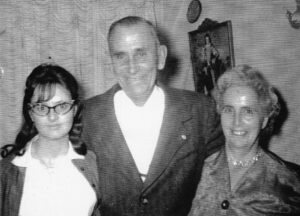 My aunt, Sandy Pattan is the youngest of my mom, Collene Spencer’s siblings. By the time Aunt Sandy came along, some of her older siblings were already dating. and when she was just two years old, her sister Evelyn got married. By the time Aunt Sandy was three years old, she was an aunt. That is very young, but then some kids are born aunts and uncles. They actually have nieces and nephews who are older than they are. That idea is really something to wrap your head around, but then again, for those born into it, being an aunt or uncle at birth is just normal. For Aunt Sandy, being an aunt is all she remembers.
My aunt, Sandy Pattan is the youngest of my mom, Collene Spencer’s siblings. By the time Aunt Sandy came along, some of her older siblings were already dating. and when she was just two years old, her sister Evelyn got married. By the time Aunt Sandy was three years old, she was an aunt. That is very young, but then some kids are born aunts and uncles. They actually have nieces and nephews who are older than they are. That idea is really something to wrap your head around, but then again, for those born into it, being an aunt or uncle at birth is just normal. For Aunt Sandy, being an aunt is all she remembers.
Aunt Sandy has long been the keeper of the family traditions. She made the arrangements for the annual Christmas party and the summer picnic. She worked so hard to keep the family together and to fulfill the wishes of her parents, Grandma (Hattie) and Grandpa (George) Byer, who asked that the family not drift apart, but continue in the traditions they had started. Aunt Sandy embraced that dream of a close family, and for 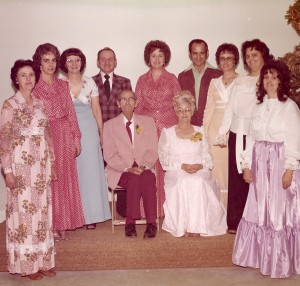
 many years, she worked very hard to carry out and establish their wishes. And she did it well. In the earlier years after Grandma and Grandpa went home to Heaven, Aunt Sandy had lots of help, because everyone got involved, but as the years went by and some of her siblings went to Heaven too, the help became less and less. Still, she persevered. These days the next generation has stepped up and let Aunt Sandy “retire” from the family get-togethers chair. Sadly, the participators have dwindled, and we just hope to have enough people to continue. That is up to the family, I guess.
many years, she worked very hard to carry out and establish their wishes. And she did it well. In the earlier years after Grandma and Grandpa went home to Heaven, Aunt Sandy had lots of help, because everyone got involved, but as the years went by and some of her siblings went to Heaven too, the help became less and less. Still, she persevered. These days the next generation has stepped up and let Aunt Sandy “retire” from the family get-togethers chair. Sadly, the participators have dwindled, and we just hope to have enough people to continue. That is up to the family, I guess.
Aunt Sandy has always lived in her own place. She tells me that she has never lived in an apartment, but that is about to change too, as she makes plans to move into an apartment in Casper. It is not an assisted living…she doesn’t need that, and she is not sure apartment living will suit her. Time will tell. If not, she can always buy another place, if she chooses. Still, I think she might like it, because the yard and building maintenance will 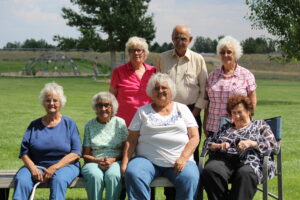
 no longer be her responsibility, and the grounds are nice, so she can get out and enjoy them…in the warm months anyway. And best of all, she won’t have to water the lawn or shovel the walks. I am excited for this new chapter in her life, even if she is apprehensive. I pray it will be such a great blessing for her, that she chooses to stay, relax, and enjoy it. I think it will be a wonderful new start. Today in Aunt Sandy’s 78th birthday. Happy birthday Aunt Sandy!! We love you!!
no longer be her responsibility, and the grounds are nice, so she can get out and enjoy them…in the warm months anyway. And best of all, she won’t have to water the lawn or shovel the walks. I am excited for this new chapter in her life, even if she is apprehensive. I pray it will be such a great blessing for her, that she chooses to stay, relax, and enjoy it. I think it will be a wonderful new start. Today in Aunt Sandy’s 78th birthday. Happy birthday Aunt Sandy!! We love you!!

 My nephew, Tucker Schulenberg is a younger uncle, and while many people might think that would seem weird, Tucker loves every minute of it. He has been an uncle for much of his life, really, because his big sister, Cassie Franklin has three kids, Lucas, Zoey, and Alicen. Tucker is also uncle to his brother, Riley Birky’s two boys, Jace (Riley’s bonus son) and Ryder. Tucker loves kids and is a great source of entertainment for them. He is a teenager, but he is and probably always will be a kid at heart. Tucker is a source of help to his brother, Riley and his fiancée, Sierah Martin. He helps out with watching their boys and keeping them happy and out of trouble. The little boys look up to him and like most little kids, want to be just like their uncle.
My nephew, Tucker Schulenberg is a younger uncle, and while many people might think that would seem weird, Tucker loves every minute of it. He has been an uncle for much of his life, really, because his big sister, Cassie Franklin has three kids, Lucas, Zoey, and Alicen. Tucker is also uncle to his brother, Riley Birky’s two boys, Jace (Riley’s bonus son) and Ryder. Tucker loves kids and is a great source of entertainment for them. He is a teenager, but he is and probably always will be a kid at heart. Tucker is a source of help to his brother, Riley and his fiancée, Sierah Martin. He helps out with watching their boys and keeping them happy and out of trouble. The little boys look up to him and like most little kids, want to be just like their uncle.
Tucker, went through some tough times after his mom, Rachel Schulenberg passed away. Rachel was such a great mom, and these days, Tucker and his siblings just try to live in a way that would make her proud of them. It’s hard to believe that Rachel has been gone now for going on 3 years. Tucker has grown up so much in those years, and I know his mom would be amazed at the young man he has become. He has gone from being an early teenager, to a young man who will soon have his driver’s license and be able to help out running errands, and possible even have a job.

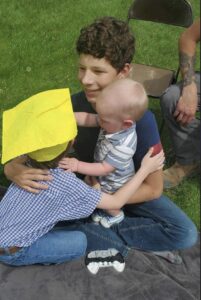
Tucker isn’t really a fan of traditional school, but it is my hope that he will at least continue his schooling online. I know that school is hard, but it is a necessary part of growing up, and I know his mom would want him to have the best education he can get. I think Tucker probably has a mechanical mind like his dad, Ron Schulenberg, uncles and cousins. It tends to run in the family, and his brother likes to tinker as well. Whatever Tucker decides to do with his life, I know he will be successful and will make his mom proud. She loved her children so much, and always wanted the best for them. Tucker is a sweet young man, and I know he will become a great adult too. Today is Tucker’s 16th birthday. Happy birthday Tucker!! Have a great day!! We love you!!
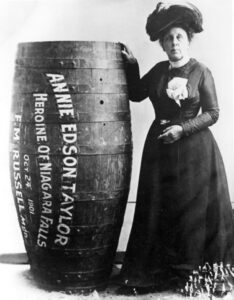
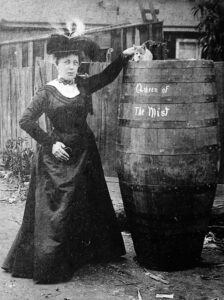 People have always been risk takers…always looking for that next thrill. Many people think that the biggest risk takers are the guys, but that is not always the case. On October 24, 1901, as a birthday gift to herself on her 63rd birthday, Anna “Annie” Edson Taylor, who was an American schoolteacher, became the first person to survive a trip over Niagara Falls in a barrel. Annie wasn’t just out to make a name for herself, but rather her motives were purely financial. Somehow, she thought this “claim to fame” would make her rich, but she never made much money from her adventure.
People have always been risk takers…always looking for that next thrill. Many people think that the biggest risk takers are the guys, but that is not always the case. On October 24, 1901, as a birthday gift to herself on her 63rd birthday, Anna “Annie” Edson Taylor, who was an American schoolteacher, became the first person to survive a trip over Niagara Falls in a barrel. Annie wasn’t just out to make a name for herself, but rather her motives were purely financial. Somehow, she thought this “claim to fame” would make her rich, but she never made much money from her adventure.
Annie was born on October 24, 1838, in Auburn, New York. She was one of eight children born to Merrick Edson and Lucretia Waring. Her father owned a flour mill and died when she was 12 years old, leaving enough money to provide a comfortable living for the family. Annie took a four-year training course, graduating with honors, and became a schoolteacher. While at college, she met David Taylor. They were married and had a son who died in infancy. Sadly, her husband died soon after. During her working years, the widowed Taylor, was often between jobs and locales.
Eventually, she moved to Bay City, Michigan, planning to become a dance instructor, except that there were no dance schools in Bay City at that time. No problem…Taylor opened her own. She moved to Sault Saint Marie in 1900 to teach music. From there, she traveled to San Antonio, Texas. Then she and a friend went to Mexico City to find work, but that venture completely failed, so she returned to Bay City. All of her moving and a number of other bad choices caused Taylor to find herself in hard times, Then, her house burned down, as well as a poor investment with a clergyman left her pretty broke. She claimed to be only 42 years old at the time and said that she could make money more easily if she were younger. Because she had always associated money and class with success, Taylor believed that she needed money to hold her place in the world. So, in the 1900 Federal Census, she declared her year of birth as 1860. She thought that if she was thought to be younger, she could make money easier.
Then, in what was most likely her craziest scheme ever, and hoping to secure her later years financially, Taylor decided she would be the first person to ride over Niagara Falls in a barrel. It seems that her money-making schemes were in endless supply. Taylor used a custom-made barrel constructed of oak and iron and padded with a mattress to make for her crazy trip. The barrel launch was delayed several times, mainly because no one wanted to be part of potential suicide. Finally, she decided she would have to do this on her own. First, two days before her own attempt, Taylor sent a domestic cat over the Horseshoe Falls in her barrel to test its strength to see if the barrel would break or not. Contrary to rumors at the time, the cat survived the plunge and seventeen minutes later, after she was found with a bleeding head, posed with Taylor in photographs. Then, on her 63rd birthday, the barrel was put over the side of a rowboat, and Taylor climbed in, carrying with her, her lucky heart-shaped pillow. The lid was screwed down, and friends used a bicycle tire pump to compress the air in the barrel. They plugged the hole used for the air with a cork, and Taylor was set adrift near the American shore, south of Goat Island.
The barrel was carried by river currents over the Canadian Horseshoe Falls, which has since been the site for all successful daredevil stunting at Niagara Falls. Shortly after her plunge, rescuers reached her barrel. Taylor was discovered to be alive and relatively uninjured, having received just a small gash on her head. The daring trip took less than twenty minutes, but it was some time before the barrel was actually opened. Taylor was helped out of the barrel by Carlisle Graham, her friend and the first man to run the rapids on a raft. After the journey, Taylor told the press, “If it was with my dying breath, I would caution anyone against attempting the feat … I would sooner walk up to the mouth of a cannon, knowing it was going to blow me to pieces than make another trip over the Fall.” Finally, she spoke some sense!! 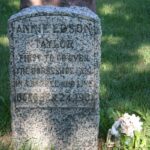
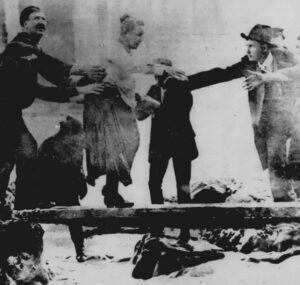
On February 23, 1921, Taylor was taken to the Niagara County Infirmary in Lockport, New York. Still lying about her age, she claimed to be 57. She died on April 29, 1921, aged 82 and was interred next to her friend and fellow daredevil Carlisle Graham, in the “Stunter’s Rest” section of Oakwood Cemetery in Niagara Falls, New York. Since she died penniless, public donations were collected to pay the costs of her funeral, which was held on May 5, 1921. She blamed her bad health and near blindness to her trip over the falls, twenty years earlier.

 My niece, Ashley Parmely has had a very busy year. Most of Ashley’s years are quite busy, so to say she has had a very busy year, is really saying something. Ashley and my nephew, Eric Parmely own a farm west of Casper, where they raise cows, chickens, turkeys, goats, pigs, horses, cats, dogs, and their four kids (three daughters and a son). Ashley is really into healthy living and raises only A2 milk cows. I didn’t know what A2 milk cows were, so I did some checking. A2 milk is a variety of cows’ milk that mostly lacks a form of B-Casein proteins called A1, and instead has mostly the A2 form. The a2 Milk Company Limited (previously known as A2 Corporation) is a dual listed NZX and ASX 50 public listed company that commercializes intellectual property relating to A1 protein-free milk that is sold under the a2 and a2 Milk brands, as well as the milk and related products such as infant formula. B-Casein is a major milk protein, representing 30% of the total protein found in cow milk. It is a member of the casein family of related phosphoproteins, which are commonly found in mammalian milk. B-Casein from bovine milk is an immunoglobulin E (IgE)-binding epitope belonging to the secretory calcium-binding phosphoprotein family. It consists of 209 amino acids and five phosphate groups. The a2 Milk Company and some companies producing
My niece, Ashley Parmely has had a very busy year. Most of Ashley’s years are quite busy, so to say she has had a very busy year, is really saying something. Ashley and my nephew, Eric Parmely own a farm west of Casper, where they raise cows, chickens, turkeys, goats, pigs, horses, cats, dogs, and their four kids (three daughters and a son). Ashley is really into healthy living and raises only A2 milk cows. I didn’t know what A2 milk cows were, so I did some checking. A2 milk is a variety of cows’ milk that mostly lacks a form of B-Casein proteins called A1, and instead has mostly the A2 form. The a2 Milk Company Limited (previously known as A2 Corporation) is a dual listed NZX and ASX 50 public listed company that commercializes intellectual property relating to A1 protein-free milk that is sold under the a2 and a2 Milk brands, as well as the milk and related products such as infant formula. B-Casein is a major milk protein, representing 30% of the total protein found in cow milk. It is a member of the casein family of related phosphoproteins, which are commonly found in mammalian milk. B-Casein from bovine milk is an immunoglobulin E (IgE)-binding epitope belonging to the secretory calcium-binding phosphoprotein family. It consists of 209 amino acids and five phosphate groups. The a2 Milk Company and some companies producing  goats’ milk products claim that milk containing A1 proteins is harmful, but there has been no widely accepted scientific work identifying a direct link between A1 protein and any adverse effect on health. Time will tell, as testing continues, but Ashley tends to agree with the current test results. If you’re like me, you probably don’t understand most of what I just said. Suffice it to say that not everything in our food is necessarily good for us. Ashley now has 2 new A2 milk cows that were both going to calf around the same time, and they birthed a day or two apart. She has been milking and feeding since that time.
goats’ milk products claim that milk containing A1 proteins is harmful, but there has been no widely accepted scientific work identifying a direct link between A1 protein and any adverse effect on health. Time will tell, as testing continues, but Ashley tends to agree with the current test results. If you’re like me, you probably don’t understand most of what I just said. Suffice it to say that not everything in our food is necessarily good for us. Ashley now has 2 new A2 milk cows that were both going to calf around the same time, and they birthed a day or two apart. She has been milking and feeding since that time.
Ashley has also started making Ghee. Ghee is a type of clarified butter, originating from the Indian subcontinent. Ghee is typically prepared by simmering butter, which is churned from cream, skimming any impurities from the surface, then pouring and retaining the clear liquid fat while discarding the solid residue that has settled to the bottom. Spices can be added for flavor. The texture, color, and taste of ghee depend on the quality of the butter, the milk used in the process, and the duration of boiling time. Personally, I am not a fan of Ghee, but many people really like it. I guess I’m just a Butter Girl. My sister-in-law, Jennifer Parmely, who is Ashley’s mother-in-law, really likes Ghee and is quite excited about the Ghee making process. She is quite proud of Ashley’s Ghee. Maybe it depends on the person making it or the spices they use. The one I “tasted” was tasteless, so my opinion could be clouded. I might have to try Ashley’s Ghee sometime.
As I said, Ashley and Eric have four kids, and the kids keep her very busy. The oldest two (daughters) are in gymnastics, while their son and youngest daughter are playing Hockey. Her youngest daughter is in pre-school, and Ashley homeschools the older three children. The busy day starts with getting her daughter to pre-school, and later she must go pick her up too. Then, the older kids have homeschooling and field trips as well. All that m
 eans that Ashley is constantly on the run. Summer was busy helping their oldest daughter with 4H projects. Last winter found the family snowed in several times. While being snowed in cramped Ashley’s busy lifestyle, she is always a good sport about it and took it all in stride. Nevertheless, I’m sure she is hoping that this winter will not be a repeat of last year’s harshness. Today is Ashley’s birthday. Happy birthday Ashley!! Have a great day!! We love you!!
eans that Ashley is constantly on the run. Summer was busy helping their oldest daughter with 4H projects. Last winter found the family snowed in several times. While being snowed in cramped Ashley’s busy lifestyle, she is always a good sport about it and took it all in stride. Nevertheless, I’m sure she is hoping that this winter will not be a repeat of last year’s harshness. Today is Ashley’s birthday. Happy birthday Ashley!! Have a great day!! We love you!!
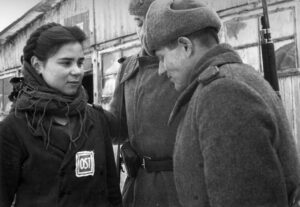 When the Germans surrendered at the end of World War II, Germany was divided into four areas of control by the Allied Powers…Great Britain in the northwest, France in the southwest, the United States in the south, and the Soviet Union in the east. Berlin, the capital city situated in Soviet territory, was also divided into four occupied zones. That gave those four countries governing control over their own sections of Germany, and the people in those areas. Not every country was exactly planning to do what the people might consider to be their best interests. The Allied countries had the control and the ability to dish out punishment as they saw fit. The Soviet Union considered the forced labor of Germans as part of German war reparations for the damage inflicted by Nazi Germany on the Soviet Union during the Axis-Soviet campaigns (1941-1945) of World War II. They wanted to exact some measure of revenge, I guess, and they were in a position to make that happen.
When the Germans surrendered at the end of World War II, Germany was divided into four areas of control by the Allied Powers…Great Britain in the northwest, France in the southwest, the United States in the south, and the Soviet Union in the east. Berlin, the capital city situated in Soviet territory, was also divided into four occupied zones. That gave those four countries governing control over their own sections of Germany, and the people in those areas. Not every country was exactly planning to do what the people might consider to be their best interests. The Allied countries had the control and the ability to dish out punishment as they saw fit. The Soviet Union considered the forced labor of Germans as part of German war reparations for the damage inflicted by Nazi Germany on the Soviet Union during the Axis-Soviet campaigns (1941-1945) of World War II. They wanted to exact some measure of revenge, I guess, and they were in a position to make that happen.
So, the Soviet authorities deported German civilians from Germany and Eastern Europe to the USSR after World 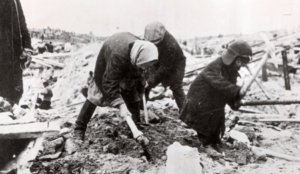 War II as forced laborers. It almost reminds me of what happened with the Holocaust, except that the Soviet Union had no interest in killing their captives. They wanted slave labor and a measure of retaliation. Ethnic Germans living in the USSR were conscripted for forced labor. German prisoners of war were also used as a source of forced labor during and after the war by the Soviet Union and by the Western Allies.
War II as forced laborers. It almost reminds me of what happened with the Holocaust, except that the Soviet Union had no interest in killing their captives. They wanted slave labor and a measure of retaliation. Ethnic Germans living in the USSR were conscripted for forced labor. German prisoners of war were also used as a source of forced labor during and after the war by the Soviet Union and by the Western Allies.
The decision was made and the fate of the German people was sealed. In 1946, the Soviet Union forcibly relocated more than 2,500 former Nazi German specialists, including scientists, engineers, and technicians who worked in specialist areas, from companies and institutions relevant to military and economic policy in the Soviet occupation zone of Germany (SBZ) and Berlin, along with around 4,000 family members, totaling more than 6,000 people, to the Soviet Union as war reparations. These specialists with all of their knowledge and abilities, could easily change the course of history in the Soviet Union, or any country they were placed in, for that matter. Still, not all of the forced labor were specialists. Many were unskilled labor, doing menial jobs.
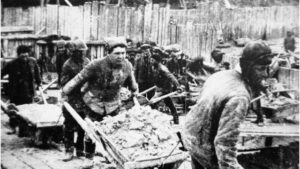
The good thing was that the situation in Germany after World War II was appalling. Many of the people were homeless from the bombings. I suppose that, for that reason, the forced move, while scary, was not the worst thing in the world. It was possible that a new life in the Soviet Union could be favorable when compared to war-torn Germany. It is unclear whether any Germans who were sent to the Soviet Union chose to go back to Germany, because information about forced labor of Germans in the Soviet Union was suppressed in the Eastern Bloc until after the dissolution of the Soviet Union in 1991. Many of those records could have also been destroyed.
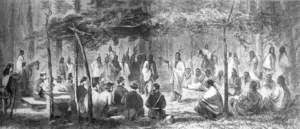 Actually, The Medicine Lodge Treaty is the name given for three treaties that were signed near Medicine Lodge, Kansas, between the Federal government of the United States and southern Plains Indian tribes on October 21, 1867. The treaties were intended to bring peace to the area by relocating the Native Americans to reservations in Indian Territory and away from European-American settlement. The Indian Peace Commission had concluded in its final report in 1868, that the wars were completely preventable. The commission determined that the United States government and its representatives, including the United States Congress, had contributed to the warfare on the Great Plains by failing to fulfill their legal obligations and to treat the Native Americans with honesty. This fact is not a new concept for anyone who has studied history at all.
Actually, The Medicine Lodge Treaty is the name given for three treaties that were signed near Medicine Lodge, Kansas, between the Federal government of the United States and southern Plains Indian tribes on October 21, 1867. The treaties were intended to bring peace to the area by relocating the Native Americans to reservations in Indian Territory and away from European-American settlement. The Indian Peace Commission had concluded in its final report in 1868, that the wars were completely preventable. The commission determined that the United States government and its representatives, including the United States Congress, had contributed to the warfare on the Great Plains by failing to fulfill their legal obligations and to treat the Native Americans with honesty. This fact is not a new concept for anyone who has studied history at all.
At the request of the tribal chiefs, the US government met the chiefs at a place traditional for Native American ceremonies. The first treaty was signed October 21, 1867, with the Kiowa and Comanche tribes. The second, with the Kiowa-Apache, was signed the same day. The third treaty was signed with the Southern Cheyenne and Arapaho on October 28, 1867. 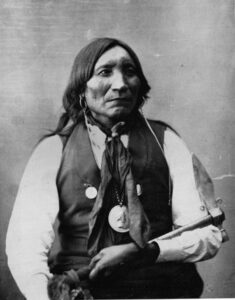
As expected, the Medicine Lodge Treaty, heavily favored the Congress and the white settlers. The tribes were assigned reservations of diminished size compared to the territories that had been defined in an 1865 treaty. The treaty tribes never actually ratified the treaty by vote of adult males…a requirement of the tribes. The Congress also changed the allotment policy under the Dawes Act and authorized sales under the Agreement with the Cheyenne and Arapaho (1890) and the Agreement with the Comanche, Kiowa and Apache (1892). With the agreement, signed with the Cherokee Commission, the Congress further reduced the reservation territory promised to the Indians. Lone Wolf, the Kiowa chief, immediately filed a lawsuit against the government for fraud on behalf of the tribes in Lone Wolf v. Hitchcock. The US Supreme Court ruled against the tribes in 1903, after determining that the Congress had “plenary power” and the political right to make such decisions. With the power of that decision to back them, Congress wasted no time in unilaterally acting in the same manner on land decisions related to other reservations as well.
Because of the outstanding issues with the treaty and subsequent government actions, in the mid-20th century, the Kiowa, Arapaho and Comanche filed several suits for claims against the US government. Over decades, they won substantial settlements of monetary compensation in the amount of tens of millions of dollars, although it 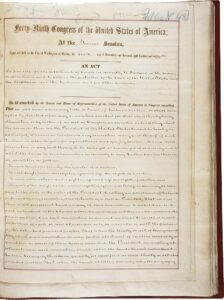
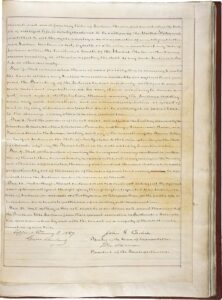 took years for the cases to be resolved.
took years for the cases to be resolved.
I don’t know what could have been done differently, exactly, other than to be completely fair with our treatment of the Indians. I have never liked the idea of forcing them to be on the reservations. The land they were given was far less than they should have received, and instead of letting them become members of society, where they could make an honest living, they were given compensation without the need to earn in, creating a group of people who could make no contribution to society at all. It basically took away their self-respect and their sense of worth…a situation which helped no one. The fighting continued until the last battle was fought on January 9, 1918.
 People in our modern-day world truly take some of history’s inventions for granted. Things that have been around for a long time, are especially susceptible. Around 3000 BC, the Egyptians used early concrete forms as mortar in their construction work. The Great Pyramids at Giza were built from an early form of concrete, and they are still standing today. It seems strange to think of concrete existing way back then, but it actually did. It might not have been in exactly the same form as the concrete of today. In fact, the Bible tells of using clay and straw to make bricks and mortar. It seems rather archaic to us these days, and but then it seems to have lasted a whole lot longer than some of the concrete of today, so maybe some of it was better.
People in our modern-day world truly take some of history’s inventions for granted. Things that have been around for a long time, are especially susceptible. Around 3000 BC, the Egyptians used early concrete forms as mortar in their construction work. The Great Pyramids at Giza were built from an early form of concrete, and they are still standing today. It seems strange to think of concrete existing way back then, but it actually did. It might not have been in exactly the same form as the concrete of today. In fact, the Bible tells of using clay and straw to make bricks and mortar. It seems rather archaic to us these days, and but then it seems to have lasted a whole lot longer than some of the concrete of today, so maybe some of it was better.
Portland cement was invented by Joseph Aspdin of England in 1824. The first concrete  paved street in the United States was laid in Bellefontaine, Ohio in 1891. The street was paved by George W Bartholomew, who owned the Buckeye Portland Cement Company and convinced city officials to let him pave an eight-foot-wide strip of Main Street with a mixture of sand, stone, and cement. Two years later, city officials agreed to let Bartholomew pave an entire block of Court Avenue between Main Street and Opera Street, which today remains the oldest concrete street in America, and it still exists, unlike some of the products currently used for streets today.
paved street in the United States was laid in Bellefontaine, Ohio in 1891. The street was paved by George W Bartholomew, who owned the Buckeye Portland Cement Company and convinced city officials to let him pave an eight-foot-wide strip of Main Street with a mixture of sand, stone, and cement. Two years later, city officials agreed to let Bartholomew pave an entire block of Court Avenue between Main Street and Opera Street, which today remains the oldest concrete street in America, and it still exists, unlike some of the products currently used for streets today.
Steel-reinforced concrete was developed by the end of the 19th century. August Perret designed and built an apartment building in Paris using steel-reinforced concrete in 1902. The building was widely admired, and with that building came a new popularity for concrete. In fact, the building influenced further development of reinforced concrete. Eugène Freyssinet really pioneered reinforced-concrete construction by building two colossal parabolic-arched airship hangars at Orly Airport in Paris in 1921.
Concrete has undergone several changes since 1921. During the 21st century, concrete manufacturers have 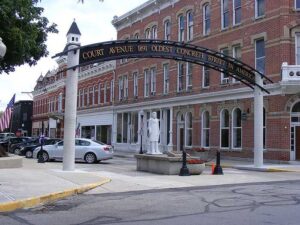 sstarted changing many of their product formulas in ways that increase early strength and lessen later age trength. This threw me a little bit, but the primary reason for this shift is said to be practical…”On a construction site, you can remove the forms from new concrete much faster if it has high early strength 1. Additionally, according to AZoBuild.com, concrete has gone through numerous changes over the last few decades despite its appearance looking almost the same. These changes include the development of environmentally friendly concrete products.” I’m not sure these changes are all that good, because they seem to cause more cracking and an earlier breakdown of the concrete. I’m not a contractor, but that doesn’t seem like a good thing to me.
sstarted changing many of their product formulas in ways that increase early strength and lessen later age trength. This threw me a little bit, but the primary reason for this shift is said to be practical…”On a construction site, you can remove the forms from new concrete much faster if it has high early strength 1. Additionally, according to AZoBuild.com, concrete has gone through numerous changes over the last few decades despite its appearance looking almost the same. These changes include the development of environmentally friendly concrete products.” I’m not sure these changes are all that good, because they seem to cause more cracking and an earlier breakdown of the concrete. I’m not a contractor, but that doesn’t seem like a good thing to me.
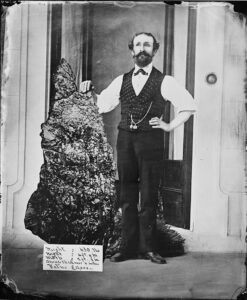 Bernhardt Otto Holtermann, who was born on April 29, 1838, was a prospector who owned part of an Australian claim where rich veins of gold were discovered after years of dry digging. I suppose it does take perseverance to successfully mine for gold, but when you consider that Holtermann finally discovered gold afteryears of digging, I would say that mining for gold also takes faith. Holtermann was born in Germany, and at adulthood set sail for Sydney, Australia in order to avoid military service. Most of his mining years were unsuccessful, including the year he even blew himself up with a premature explosion of blasting powder. Of course, his accidental explosion did not kill him, and must not have been very strong, because at the time of his greatest find, he still had all his limbs.
Bernhardt Otto Holtermann, who was born on April 29, 1838, was a prospector who owned part of an Australian claim where rich veins of gold were discovered after years of dry digging. I suppose it does take perseverance to successfully mine for gold, but when you consider that Holtermann finally discovered gold afteryears of digging, I would say that mining for gold also takes faith. Holtermann was born in Germany, and at adulthood set sail for Sydney, Australia in order to avoid military service. Most of his mining years were unsuccessful, including the year he even blew himself up with a premature explosion of blasting powder. Of course, his accidental explosion did not kill him, and must not have been very strong, because at the time of his greatest find, he still had all his limbs.
Holtermann’s “claim to fame” gold nugget was the largest gold specimen ever found, 59 inches long, weighing 630 pounds, and with an estimated gold content of 3,000 troy ounces. It was found at Hill End, near Bathurst, New South Wales. The nugget brought him enough wealth to build a mansion in North Sydney. Today, the mansion is one of the boarding houses at Sydney Church of England Grammar School (known as the Shore school). While working with one of his partners and later brother-in-law, Ludwig Hugo ‘Louis’ Beyers in their Star of Hope Gold Mining Company, in which he and Beyers were among the partners, they struck it rich. On February 22, 1868, Holtermann married Harriett Emmett, while Beyers married her sister Mary. On October 19, 1872, the Holtermann Nugget was discovered. While it was not “strictly speaking” a nugget, it was a gold specimen, a mass of gold embedded in rock, in this case quartz. Holtermann attempted to buy the 3,000-troy-ounce specimen from the company, offering £1000 over its estimated value of £12,000 (about AU$1.9 million in 2016 currency, AU$4.8 million on the 2017 gold price),  but was turned down, and the nugget was sent away to have the gold extracted. Holtermann was so upset about that, that resigned from the company in February 1873.
but was turned down, and the nugget was sent away to have the gold extracted. Holtermann was so upset about that, that resigned from the company in February 1873.
Holtermann did manage to get a photograph of himself with the nugget. This famous photo of Holtermann next to a giant “nugget” was taken by an unknown photographer. After leaving the Star of Hope Gold Mining Company, Holtermann was elected as a member for Saint Leonard’s parliament in 1882. Tragically, at the young age of just 47 years, Holtermann died in Sydney, Australia on his birthday, April 29, 1885, of “cancer of the stomach, cirrhosis of the liver, and dropsy.” He left behind his wife, three sons, and two daughters.
 Bent Faurschou Hviid, who was born January 7, 1921, later became a member of the Danish resistance group Holger Danske during World War II. Because of his red hair, Hviid was nicknamed “Flammen,” which means “The Flame.” In 1951, he and his Resistance partner Jørgen Haagen Schmith, were posthumously awarded the United States Medal of Freedom by President Harry Truman. The Presidential Medal of Freedom is the highest civilian award of the United States, alongside the Congressional Gold Medal. The award is not limited to US citizens and, while it is a civilian award, it can also be awarded to military personnel and worn on the uniform.
Bent Faurschou Hviid, who was born January 7, 1921, later became a member of the Danish resistance group Holger Danske during World War II. Because of his red hair, Hviid was nicknamed “Flammen,” which means “The Flame.” In 1951, he and his Resistance partner Jørgen Haagen Schmith, were posthumously awarded the United States Medal of Freedom by President Harry Truman. The Presidential Medal of Freedom is the highest civilian award of the United States, alongside the Congressional Gold Medal. The award is not limited to US citizens and, while it is a civilian award, it can also be awarded to military personnel and worn on the uniform.
If you were to ask the men who were a part of the Holger Danske, they would tell you that no other resistance member was as hated or sought after by the Germans as was Hviid. Leader of the Holger Danske from 1943 through 1945, Gunnar Dyrberg said in the 2003 Danish documentary film, “With a Right to Kill,” that no one knows exactly how many executions “The Flame” performed, but he was rumored to have killed 22 persons. In all, it is said that the Holger Danske carried out an estimated 400 executions…performed by the Resistance agents, but apparently no one man executed more than Hviid.
Hviid grew up during World War I and was 20 when the Germans occupied Denmark. He was not about to just sit back and let the Nazis take over his country…at least, not without a fight. He entered the Holger Danske resistance group in Copenhagen. He was assigned to kill Danish Nazi officials and collaborators…traitors, who in Hviid’s opinion, did not deserve to live.
“Flammen” often partnered with “Citronen” whose real name was Jørgen Haagen Schmith. “Citronen” means “the lemon.” Schmith got this nickname because he sabotaged a Citroën garage, destroying six German cars and a tank. Citronen usually drove for Flammen, who executed their given targets. The two men were the most famous resistance duo in Denmark during World War II. While they often worked together, the Germans put the highest bounty on Flammen’s head that they offered for any Resistance fighter, due to the Faurschou of Germans who were executed by Flammen.
On October 18, 1944, while Hviid was having dinner with his landlady and some other guests, someone knocked at the door. When the door was opened, a German officer demanded entry. Hviid, who was unarmed  that evening, quickly went upstairs seeking to escape across the roof. When he reached the roof, he saw that the house was surrounded. Refusing to be taken alive, Hviid chewed a cyanide capsule and was dead a few seconds later.
that evening, quickly went upstairs seeking to escape across the roof. When he reached the roof, he saw that the house was surrounded. Refusing to be taken alive, Hviid chewed a cyanide capsule and was dead a few seconds later.
The witnesses later told of how they could hear the German soldiers upstairs cheering at the sight of the corpse. For the Germans, the form of death that took “The Flammen” out made no difference to the German soldiers. All that mattered was that he was dead. The soldiers dragged Hviid downstairs feet first, repeatedly causing his head to bang against the stairs as they went. I suppose it was a show of disrespect or perhaps, triumph for them, although they did not cause his death really.

